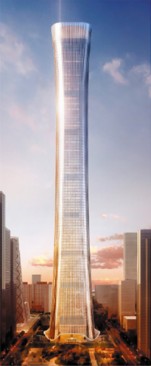Structural Design of China Zun Tower

The erecting 528-meter China Zun tower, which construction started in 2011, will be the tallest building in Beijing once built. The building design inspired by an ancient Chinese vessel “Zun”. The plan dimensions reduce gradually from bottom to the waist and then escalate bigger as it approaches to the top to form an aesthetically beautiful and unique geometry. To satisfy the structural requirement for seismic and wind resistance. The structure is a dual system composed of the perimeter mega structure which is made of composite mega columns, mega braces and belt trusses, and the reinforced-concrete core with steel plate embedded walls. Advanced parametric design technology is applied to find the most efficient outer perimeter structure system. The seismic design basically follows a mixed empirical and performance-based methodology which was verified by the shaking table test and other specimen lab tests. The tower is now half-way in its construction.
The Background
Compared with the frequently refreshed building height records in other China cities, Beijing’s skyline is rather stable. It is partially because of the strict height limit in the central Beijing to protect the view of the Forbidden City area, and also due to the extra difficulty due to the high seismic fortification intensity set for Beijing (PGA=0.2g for 475-year return period) which is higher than any other major China cities.
The 330m tall China World Trade Center held the record of height since 2008. In 2010 the plan of the CBD Core Area was initiated including 17 towers with height ranging from 50m to 500m. Located east to the East Third Ring road, it immediately raises the skyline of east Beijing by about 200m. The “China Zun” tower is the topmost building among them, containing 350,000 m2 GFA above ground and reaching 528m high with 108 floors. Developed by CITIC Heye Investment Co. Ltd, it will become the tallest building in the similar high seismic zone around the world, compared with cities like Taipei and San Francisco.
Full content of this issue you can read here
The full version of the article can be read in our printed issue, also you can subscribe to the web-version of the magazine
 Materials are courtesy of CTBUH
Materials are courtesy of CTBUH
Text: Liu Peng, Cheng Yu, Zhu Yan-Song


